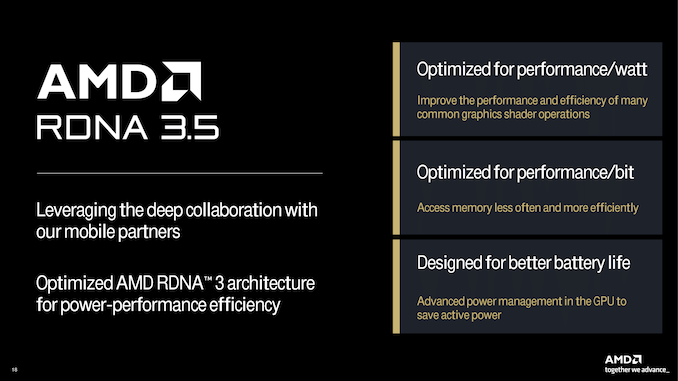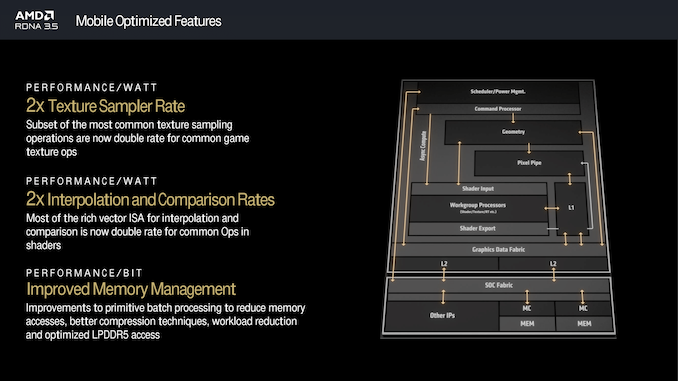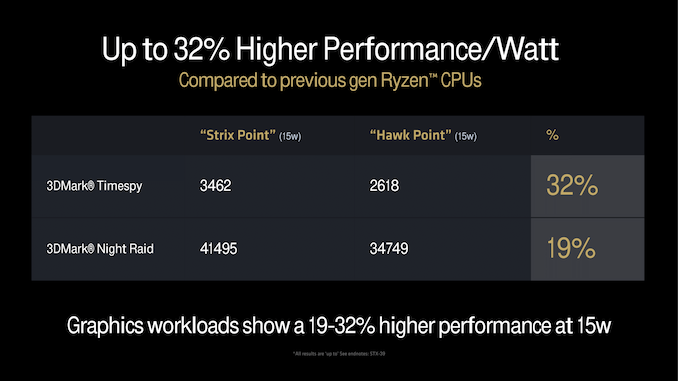The AMD Zen 5 Microarchitecture: Powering Ryzen AI 300 Series For Mobile and Ryzen 9000 for Desktop
by Gavin Bonshor on July 15, 2024 9:00 AM EST- Posted in
- CPUs
- AMD
- Mobile
- Zen 5
- AM5
- XDNA 2
- Ryzen 9000
- Ryzen AI 300
- RDNA 3.5
- Radeon 890M
AMD Ryzen AI 300: RDNA 3.5 Graphics Brings The Visuals
Another new technology coming with Zen 5 for the Ryzen AI 300 mobile series chips is upgraded integrated graphics. AMD's RDNA 3.5 graphics architecture represents what looks to be a stepping stone (sans the .5) to the next generation of AMD's graphics architecture. This latest iteration has been designed to enhance both performance and efficiency, with a focus on optimizing every last drop of performance per watt. It's worth noting that AMD hasn't provided many details about RDNA 3.5, so we'll dive into the key features and advancements.
The AMD RDNA 3.5 graphics architecture represents the next step in integrated graphics for their Ryzen AI 300 mobile SoCs, with some notable upgrades over RDNA 3. AMD has been working closely with ISVs and developers to ensure that RDNA 3.5 provides everything AMD says it will be working hand-in-hand with mobile partners for better performance per watt in games. Some improvements include general graphic shader operations, which are optimized to ensure things work as they should. AMD has put a lot of focus on the performance per bit, which not only reduces the times of memory accesses but it also makes the operations smoother. The general cusp of the improvements is all around power vs. performance, with AMD aiming for the middle ground to ensure a longer battery life, which is vital in mobile and portable devices.
Much of the improvements over RDNA 3 come through several features that have been specially optimized for mobile platforms. This ensures that the Radeon 890M, which is the model with the Ryzen AI 300 series, has the best of both worlds in terms of efficiency and visual performance. The rate of texture sampling has been doubled, which ensures double-rate performance from the GPU. What it means on the surface is enhanced detail and clarity of the textures and graphics during gameplay. This, in theory, should help improve detailed textures so they look great when playing high-resolution games. Further to this, RDNA 3.5 has 2X the interpolation and comparison rate, as vector ISA operations can work much better to bring out detail in high-quality graphics.
Another critical improvement is better memory management techniques. These reduce the frequency of memory access, meaning data processing should, in theory, be faster and overall more energy-efficient. Optimized LPDDR5 access should also guarantee fast and efficient memory use, which in turn should aid battery life.
AMD has provided some performance figures comparing RDNA 3.5 to RDNA 3, with some pretty impressive claims if they translate into real-world performance. On paper, the RDNA 3.5 architecture shows a significant performance uplift compared to the previous generation Ryzen 8040 series, with up to 32% higher performance per watt. In graphics workloads like 3DMark Timespy and 3DMark Night Raid, AMD claims that RDNA 3.5 has an uplift of between 19 and 32% in terms of performance at 15 W.
Because of these improvements, RDNA 3.5 is improved in various ways compared to its predecessor, RDNA 3. For example, RDNA 3.5 greatly increases the GPU's capacity to execute complicated graphics operations more effectively by optimizing key things such as texture sampling and interpolation. Improving the memory management in RDNA 3.5 also allows for better power optimization and data handling to address major GPU performance issues. All of these should bring real-world performance benefits. However, as with any mobile SoC, these still aren't on the level of discrete graphics, which typically have more die area to play with, a higher transistor budget at the manufacturing level, and, of course, more power.













43 Comments
View All Comments
kpb321 - Monday, July 15, 2024 - link
I do like that they are dialing back the TDP on these chips some. The 7000 desktop chips seems to push that a little too hard to be the fastest. A little too much of the Intel overclocked to the edge from the factory there. Nice to see them backing down from that so we don't start seeing issues similar to the i9's.Gavin Bonshor - Monday, July 15, 2024 - link
AMD doesn't need to push higher wattages, which makes them more attractive from a perf/watt standpoint.Kangal - Tuesday, July 16, 2024 - link
What would have REALLY been impressive is if AMD had also designed, announced, and released an AM5p Motherboard Platform. Something that is similar to the Desktop AM5 Motherboards but this time it is for Laptops, with the key feature being accessibility. So that can upgrade the CPU, RAM, SSD as the months go on. And maybe even a socket for dGPU.I am aware of the Frameworks Laptop, but it would have been much better having this come directly from AMD. It would have really separated AMD as a premium option for laptops, against a walled/locked Intel platform, or the competitive ARM options coming in the future.
Just like how it was a massive upgrade to go from the first 8-core (r7-1700) to the last 8-core (r9-5800x3D) option on the AM4 Platform. It would have been great to see that on their AM4 Laptops (eg 4-core to 4-core for efficiency). But I understand that. Does not mean it cannot happen for AMD Laptops with this AM5 Platform though.
So yeah, AM5p Motherboards.... let's do that please!
zamroni - Tuesday, July 16, 2024 - link
I'd love to get those components user upgradable but soldered components reduces overall hardware production costs.you also can't get unsoldered lpddr, which is also faster than dimm ddr.
as long as the ssd is removable and 2280 slot spec, I'm fine with it.
i just wish all laptop manufacturers give option not to include windows.
i saw in hp website that it reduces the price by at least 100 dollar for the elite book model
TheinsanegamerN - Tuesday, July 16, 2024 - link
They could get around that with CAMM, which is modular but offers LPDDR speeds.Hifihedgehog - Tuesday, July 16, 2024 - link
Indeed. This is the trajectory of the market: CAMM. All of the benefits of lower power and higher frequencies of LPDDR memories with the added benefit of user upgradability. Link below:https://www.techpowerup.com/322754/lpddr6-lpcamm2-...
TheinsanegamerN - Tuesday, July 16, 2024 - link
I'd love it, unfortunately the world is moving more to throw away soldered designs, because screw reparability, upgradeability, or what some consumers want.Hifihedgehog - Tuesday, July 16, 2024 - link
https://www.techpowerup.com/322754/lpddr6-lpcamm2-...Terry_Craig - Tuesday, July 16, 2024 - link
In fact CAMM2 offers the best of both worlds.Silver5urfer - Tuesday, July 16, 2024 - link
Intel screwed up does not mean AMD's Arch also follow same. AMD's Zen 3 processors ran at 1.4V, Intel Sandy to SKL all ran at 1.4V. None of them exhibit the damn instability or the degradation to the point of no return.AMD needs to step up their TDP and wattage, the 9950X barely beats a 7950X. It's mediocre 41K CBR23, vs Zen 4's 38K. Compare to the Zen 3 vs Zen 4, the jump was over 14000points in CBR23.
AM5 socket is capped to 230W, no amount of PBO will exceed that. And PBO added Zen 4 goes to 40K and Zen 5 with Curve Shaper and PBO2 it will go upto 45K max.
AMD could have added more power, 50W for the R9, 25W for the R7 but they instead reduced it massively and also cut down the Base Clocks by a lot of MHz. Wonder if it's due to Intel's ARL dropping SMT / Hyperthreading.